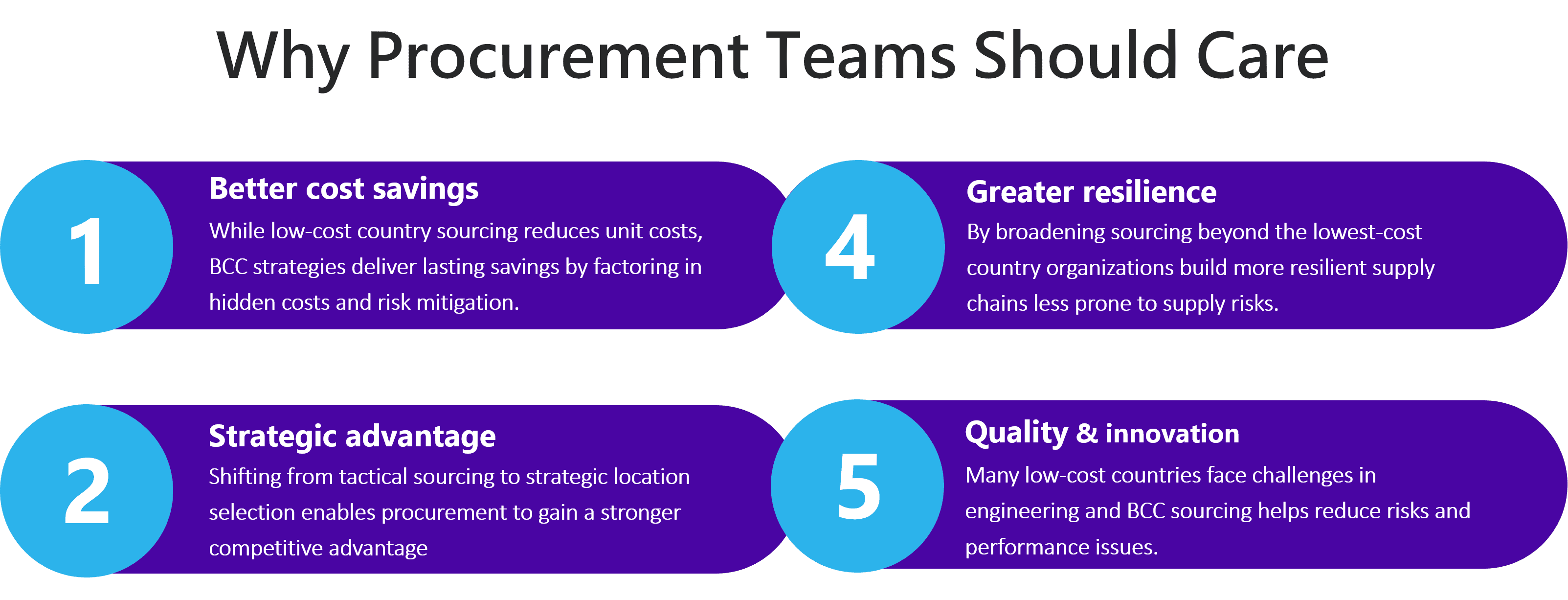Due to rising labor costs in many international supply chains, logistics bottlenecks, geopolitical risks, and increasing pressure for sustainability, the old strategy of sourcing from the “lowest cost country” simply is not enough. While sourcing from the lowest cost country probably allowed some short-term savings, it probably also introduced higher risks for poor quality, interruptions in supply, or many other hidden costs. This is where the term Best-Cost Country (BCC) sourcing comes in - a more thoughtful and strategic way to think about overall cost and value. The question now changes from “How cheap can we go?” to “What location has the overall best cost and value based on cost, capabilities, quality, dependability, risk, of this category?”
What is BCC Sourcing?
Best-Cost Country sourcing means choosing sourcing locations with what we call the best overall value proposition, as opposed to the lowest per unit cost. The key dimensions are:
Total Cost of Ownership (TCO): labour, materials, utilities, logistics, duties, tariffs, cost of holding inventory, quality cost, after sales costs.
Supplier performance: quality consistency, engineering capability, production flexibility, lead time, on-time delivery.
Country / location risk & fit: political & regulatory stability, cultural fit, infrastructure, currency & trade regime, reliability of logistics.
Strategic alignment: Does the sourcing location fit with your business strategy (innovation, speed to market, regional access), and not just savings?
So to sum up: BCC sourcing is about adding value rather than just saving costs.

Key Elements of a BCC Sourcing Strategy
Define category and business requirements: For each expense category (components, services, raw materials), specify cost target, quality, lead time, innovation, geographic/regional limitations, ESG/sustainability, and supplier development needs.
Different categories might need different “best cost” geographies.
Develop a country evaluation framework: Incorporate cost considerations (labour, materials, utilities), logistics (freight, ports, inland), trade/tariff/duties, currency risk, inventory cost, quality/rework cost.
Short-list suppliers and locations: Catalog supplier landscape in targeted geographies: number of capable suppliers, certifications, cluster maturity, secondary suppliers, potential risk of single-sourcing. Conduct factory audits, sampling test and supplier capability assessment.
Governance, monitoring and continuous review: When transitioning from existing sourcing to a new BCC location, plan phase-in and phase-out, manage inventory buffers, coordinate logistic adjustments, and communicate with stakeholders.

Relevance for Indian Procurement & Sourcing Teams
For procurement teams in India (or those sourcing from/within Asia), BCC sourcing has some specific context:
India itself is becoming a “best-cost” country for a number of categories: skilled labour, improving infrastructure costs, competitive cost base, English-language capability.
At the same time, sourcing elsewhere (Vietnam, Malaysia, Eastern Europe, etc.), may be a viable “best cost” option depending on category. Some companies are adopting the “China + 1” sourcing model for example.
For Indian companies who are sourcing for global markets, BCC can also help validate whether or not India is the leading option for a given category, or if they should have a diversified sourcing base.
Logistics and proximity (to the Middle East, Africa, Asia Pacific markets for example) may factor into the “best cost” decision in addition to cost.
BCC Sourcing in Practice
A success story: a global manufacturer in Western Europe faced the need to lower production costs and diversify their suppliers. They initiated a BCC sourcing strategy, which included: building a cross functional project team, short-listing countries, e.g. India, Turkey, Eastern Europe for their final source, qualifying new suppliers, implementing digital audit & risk management, transferring €130 million worth of purchasing volume, and extracting approximately €28 million of annual savings.
This indicated a BCC strategy not only demonstrated cost savings, but also improved resilience through supply base diversification beyond high-cost countries.
At UnivDatos, we are in a strong position to help you make the most of BCC sourcing. With our robust analytical capabilities and global sourcing intelligence, we assist you with:
Finding optimal sourcing locations and benchmarking sourcing decisions. We will use cost-data, country-level risk analysis, supplier ecosystem maturity. Development a sourcing playbook: category-specific sourcing strategies, supplier short-list and capability assessment, and risk mitigation (quality, logistics, compliance). Implementing the sourcing shift with strong governance; we work through phased transition, supplier on boarding, performance-monitoring, and continuous optimisation to build supply-chain resilience and value capture.
Contact our analytics experts to schedule a consultation and uncover how we can accelerate your journey of becoming a data-driven organization.
